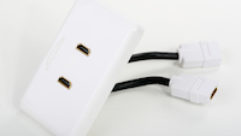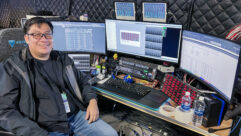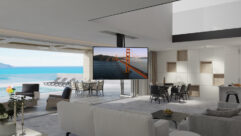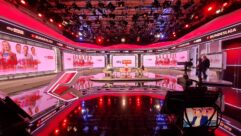
Installation Profile: Conventional Wisdom
Oct 1, 2004 12:00 PM,
By Bruce Borgerson
QSC Audio
www.qscaudio.com
Stewart Filmscreen rear-projection screen with smaller displays on stage.
When nominees John Kerry and George Bush stepped up to the podium and delivered their acceptance speeches at their respective party conventions, they presented sharply different messages to the nation. Yet each candidate spoke through the same type of Schoeps microphone, and most supporters in the two halls heard the rousing speeches through the same type of JBL loudspeakers. Perhaps even more surprising is the fact that most of the loudspeakers were the same units, owned by the same rental company, and that the sound designer for both events — who also doubles as the front-of-house (FOH) mixer — was the same person.
Certainly, this even-handed bipartisanship did not originate in high party circles. Such technical details are wisely passed from political operatives into the hands of third-party event production professionals. Nevertheless, this extraordinary agreement across party lines underscores a common philosophy: when it comes to communicating through technology, invest wisely.

Raised false floor, Barco ILite display, and existing SPLIS installed delay speaker at the RNC.
SMOKE-FILLED ROOM TO MEDIA EVENT
Before the advent of television, America’s quadrennial national conventions were extensions of the smoke-filled backroom. Significant decisions by power brokers occurred between the gavels. No longer. Gradually transformed into scripted media events, the party conventions were sapped of real drama. Viewer interest and network coverage waned. For this year’s conventions, gavel-to-gavel coverage was relegated to cable’s C-SPAN. Although PBS and the cable news networks offered extended prime-time coverage, the big commercial networks checked in only briefly for “headliner” speeches.
Curiously, the reduced TV coverage served to amplify the need to make the maximum impression in the minimum time. The look of the hall — video screens in particular — now has to come across with the full desired effect, and the sound system must raise the excitement level of the faithful to a fever pitch without stepping on the broadcast sound. Achieving those goals requires considerable advance planning along with widespread application of advanced AV technology.
A TALE OF TWO CITIES
Both conventions were held in basketball/hockey arenas with about 20,000 full seating capacity: Boston’s Fleet Center and New York’s Madison Square Garden. The Fleet Center (Democrats) was completed in 1995 with permanent audio systems installed by SPL Integrated Solutions (SPLIS). The venerable Madison Square Garden (Republicans) opened in 1968 but has undergone a number of audio system renovations. The latest upgrade, in 2001, was another SPLIS installation.

The permanent systems at both arenas were designed principally for sports applications, with limited coverage for floor seating, particularly when full bandwidth music is applied. However, the sound requirements for a political convention fall in line with those for a rock concert: prime seating is on the floor, and robust, full-range music reinforcement is required throughout the arena. At the same time, because the convention is staged as a broadcast friendly event, all loudspeaker systems must be tucked away overhead or otherwise placed out of sight to the greatest degree possible.
Juggling these oft-conflicting requirements demands particular expertise, so it’s not surprising that the event professionals in charge of both conventions turned to Patrick Baltzell for sound design. Based in Sherman Oaks, California, Baltzell has designed the convention audio systems for the Democrats since 1988 and the Republicans since 1992. Other high-profile credits include seven Super Bowls, the opening and closing ceremonies of the Olympic Games in Atlanta and Salt Lake City, and numerous Grammy and Oscar awards ceremonies. For most of these big events, Baltzell also serves as the primary FOH mixer.
UNCONVENTIONAL CHALLENGES
According to Baltzell, a political convention is similar to other large-scale televised events in several respects. However, when compared with a Grammy Awards or a Super Bowl, the event presents “unconventional” challenges. Those include:

Sound system designer and FOH engineer Patrick Baltzell.
Superb speech intelligibility and full-range music reproduction
Rarely do both of those requirements demand essentially equal emphasis, particularly in a large arena setting.
Seamless coverage and balanced levels for all ambient conditions
Political conventions are peculiar in that everybody must be able to hear and understand the speaker at the podium at all times, even if most are not listening! Ambient noise level can be high (85 to 88 dB) as delegates and the press converse during the “not for prime time” speeches.
Multiple press audio feeds
Dozens of separate audio feeds are required. Most are mono, but in some cases, stereo is requested. Some TV networks also require separate audio stems — submixes of main elements such as podium microphone, stage music, music vocals, and so on.
Multiple ancillary systems
In addition to multiple stereo and mono feeds for the main FOH system, audio must be sent to the installed delay rings for upper seating levels, as well as back-of-house and concourse systems, special press speaker systems, and the MATV system.
Sprawling floor microphone systems
Although rapidly becoming a relic of a bygone era, for the time being, more than 50 dedicated microphones are required for delegations on the floor.

JBL Vertec line arrays and a Stewart Filmscreen rear-projection screen were used at the Democratic National Convention in Boston.
RF density
Hundreds of wireless systems are jammed into limited frequency space, requiring vigilant on-site monitoring by the FCC.
Mixed skills at the microphone
Unlike an Oscars telecast, where presenters are skilled professionals, a political convention involves a wide spectrum of podium talents.
“This is undoubtedly as complicated as it gets,” says Baltzell. “Not only do I have to keep track of all the main P.A. zones, I also need to stay on top of what’s happening with the front fills, the house delay rings, and all the isolated press feeds. There’s really no other event I’m involved with that’s quite like it.”
Political conventions also are outside the norm in the generous time frame allowed. The two major parties lock out their host arenas at least a month in advance, easily accommodating temporary installation of AV systems on a grand scale. However, even though most systems profiled here were brought in specifically for the conventions, consultants and contractors will note an important implication: technology already in place does not have to be rented. Incorporating more of the needed technology into a new permanent system certainly would give an arena and its host city a competitive edge when scrutinized by the convention site selection committees.

Rear-projection screen with smaller displays onstage at the Democratic National Convention.
BOSTON AUDIO
Effective management of these multiple challenges requires strategic system design, with extraordinary attention to hundreds of critical details. A walk-through of systems used for the 2004 conventions reveals a common overall approach, though with significant variations. Proceeding in chronological order, the system deployed for the Democratic National Convention (July 26-29) is sketched here first. Primary systems provider was ATK AudioTek of Burbank, California, with substantial subrentals of the Vertec arrays from Boston’s Scorpio Sound.
At Boston’s Fleet Center, the 170-foot-wide, dual-stage set was erected on one wide side of the arena, with audio coverage required for nearly 300 degrees of the seating bowl. The primary house system, covering the floor and some front bowl seats, comprised six clusters of JBL Vertec 4889 line array loudspeakers, five with 12 cabinets and one with 10. For most of the upper bowl seats, Baltzell specified a delay ring with eight arrays of the smaller JBL Vertec VT 4887 units, supplemented by four dual-speaker clusters of AudioTek’s proprietary C-6 three-way unit. Sub-bass was provided by ground-stacked AudioTek dual 18-inch subwoofers. Digital signal-processing (DSP) system controllers were XTA 226 and 224 models, and all power amplifiers were from QSC Audio.
To boost intelligibility in the upper-level seats and far corners, the temporary system was tied into selected parts of the permanently installed system. For the rear corners, two of the existing EAW clusters remained active. The upper-level distributed system of JBL ceiling speakers was energized, as well, with both systems driven by Crown Audio amplifiers. SPLIS system engineer Mike Moats flew to Boston to assist Baltzell in reconfiguring the system and setting the proper delay times.
“Normally, I would simply coordinate integration with the venue’s staff operator,” Baltzell says. “But for this year’s conventions, for the first time, I decided to work with directly with the installation company, which happened to be SPLIS for both. First, SPLIS supplied me with all the raw CAD data I needed to merge the existing system clusters into the drawings with my temporary systems. Later, on site, their guys were able to rework the DSP systems used for the delays to give me exactly what I needed. This not only saved a great deal of my time, but it also gave the venue a much greater comfort level than would be the case if I had asked to make major changes, which certainly had to be done in New York.”
Baltzell’s main room design also included subsystems for front fill (Electro-Voice DMX loudspeakers and JBL Vertec 4887 arrays) and a rear press area system (E-V DMX). Elsewhere in the hall, he specified self-contained rehearsal room and a press conference systems. But perhaps most unusual is the special system devised for the press tables: a complement of 220 Fostex 6301B small, active tabletop loudspeakers. “I keep the room levels in the press area down to where they can converse and talk on the phone,” says Baltzell, “but then they have these little boxes to jack up the volume when they want to focus on a particular speaker or record what they’re saying.”
TRICKS OF THE TRADE
When it comes to maintaining high intelligibility and a natural voice quality, Baltzell reveals tricks of the trade that could be applied in many permanent installations, as well. It begins with microphone selection, in this case a custom assembly (by ATK, though others have done it, as well) that incorporates two Schoeps capsules on a single stem: an MK41S hypercardioid and an MK40 cardioid. The combination lets Baltzell use the hypercardioid pattern — to minimize off-axis noise — on experienced speakers or mix in the cardioid on podium novices who stray further from the microphone. Identical microphone assemblies were mounted on each of the three podiums in Boston.
On the processing side, Baltzell carries his own FOH racks, which he patches as a sidechain into the main mixing console, a Yamaha PM-5000 at both conventions. The racks contain an assortment of gear, but two pieces are critical for this application: a Dolby 430 dialog gate and an XTA 324 SIDD.
“The Dolby unit was made for film and postwork as a single-ended device for cleaning up location dialog tracks,” says Baltzell. “It’s a variable threshold gate, and for this application, it removes reentry into the P.A. and gives another 3 dB of gain without getting close to feedback.”

One of five Digital Projection Lightning 28sx DLP projector stacks for the DNC (note top projector is inverted).
Baltzell uses the XTA device to fine-tune dynamics and equalization of the podium microphone. “I energize the sound system and then use the Smaart analysis program with the podium mic as the measurement microphone,” he says. “Then I tweak the XTA SIDD to remove off-axis energy coming back into the microphone. It’s very effective.”
With those two devices devoted to maximizing gain before feedback, Baltzell reserves the EQ strip on the Yamaha console for fine-tuning the response of each speaker at the podium.
MUSIC AND MICROPHONES
Music in Boston was performed by a top-notch house band, which entertained during breaks and also backed up notable performers like John Mellencamp and Willie Nelson. All music was mixed on an InnovaSon Grand Live with 48 inputs, with snapshot mixes for each act developed during the sound checks. A Yamaha PM1D set behind the stage supplied the multiple monitor mixes.
More than 100 hardwired microphones were on hand for the band, vocalists, hall ambience for broadcast, and general use. The selection included a wide assortment of models from Shure, Sennheiser, and Neumann. On the wireless side, however, only 12 Shure microphone transmitters were allowed by the strict FCC compliance team, though 8 more frequencies were allowed for the Shure in-ear monitoring systems.
Finally, to give each delegation a few seconds of glory, there was the additional subsystem of 55 microphones spread out across the convention floor. The Shure SM-57 microphones feed a custom 55-in-by-4-out custom switcher that automatically selects the proper microphone (and mutes all others) in response to a MIDI command from a rostrum-mounted computer.
REPUBLICANS: SURPRISE SOUND

Existing scoreboard display with speaker arrays and large display from the FOH position at the RN.C
When the political action shifted to New York (August 30-September 2), the temporary audio systems deployed in Madison Square Garden bore a remarkable resemblance to those in Boston.
Certainly, the main bowl system used for the first three nights of the convention adhered closely to the Boston template, which is not surprising because the rostrum had the same long-side orientation, and the two arenas are close to the same size. The main floor systems were practically identical, using the same number of JBL Vertec VT 4889 array clusters, with only a two-cabinet difference in the loudspeaker count. Because of the more “in the round” setup, the delay ring in New York was a symmetrical arrangement of 12 Vertec VT 4887 arrays of five cabinets each. Other fill and auxiliary systems were essentially variations on the same theme, using similar or identical components but with different counts and orientations. Primary system provider again was ATK AudioTek, this time with supplementary Vertec cabinets provided by See Factor of Long Island City, New York.
Madison Square Garden would have been largely a carbon copy system if it weren’t for a decision, made at the higher echelons of the party, to have the president give his Thursday night acceptance speech not from the side rostrum but from a small, 20-foot-diameter platform in the center of the arena. (The small stage was erected and all floor seating reconfigured overnight.) This change of focus created a dilemma for Baltzell. The primary floor system was designed for full coverage with a zero point at the side rostrum, but now he had to switch the auditory reference point to dead center.
“I tried to think of some way to do it by moving only some speakers and reworking the delays,” he says. “I played with notions of redeploying and reaiming speakers by swiveling or putting them on some kind of trolley. But it just didn’t work. The only way to do it was to hang a completely separate main floor system just for that one hour of the convention.”
Unwilling to compromise on such an important speech, the convention managers grudgingly approved his dual-system plan. A separate loudspeaker system was ordered and flown, comprising 80 additional VT 4889 cabinets in eight arrays, driven by separate XTA 226 controllers.
LINKING THE DELAYS
Fortunately, because the delay ring was symmetrical, no outer arrays had to be moved or added; this reconfiguration could be accomplished electronically with a preset change in delay times. The same approach applied to the critical tie-in with the permanent delay system for the upper seating tiers. Larry Politti of SPLIS was called in to assist with this facet of the system transformation.
“This was by far the biggest change I’ve had to make since we put it in,” says Politti, who served as project manager for the installation. “I had to reprogram the [BSS] Soundwebs to take out all of our processing and delays and provide a dry feed to the amplifiers. All the delays were programmed into Patrick’s XTA units so he could change them with a preset cue before and after the big speech.”
The delayed signals were routed through a Soundweb fiber-optic interface into a QSC Audio RAVE digital distribution system into the assigned racks of QSC amplifiers. The concentric upper delay rings employ Renkus-Heinz TRC Series surfacemount and OWI ceiling speakers.
Other changes made for the Republican Convention were relatively minor. Perhaps mindful of a stodgy image from the past, the convention planners decided to have more artists playing with their own bands, with all acts emerging from under the false floor (built 10 feet above the concrete just for the convention) on a hydraulically lifted stage. To accommodate the extra inputs and preset complexity, the music mixing console was switched to a Yamaha PM1D. (For more about the false floor, go to www.svconline.com for a Web exclusive.)
VIDEO: DEMOCRATS GO WIDE
From a video standpoint, the basic requirements were not dramatically different for the conventions as compared to similar large-scale entertainment or corporate events. However, with all the options opened by new technology, the two conventions did exhibit notably different approaches.
The Democrats in Boston decided to “go wide,” with a single long dias connecting two side stages with the center rostrum. Fitting in with this design, the dominant video feature was a seamless 90-by-17-foot rear-projection screen, custom-made for the event by Stewart Filmscreen Corp. Projectors were five stacks of two each Lightning 28sx DLP units from Digital Projection International. Projector feeds were from the dedicated video truck, which selected from in-house cameras, prerecorded video segments, and nightly live satellite feeds from around the country.
“This wide screen was a significant change from the traditional 4-by-3 ratio image magnification we’ve seen in the past,” says Murray Lapides of Boston’s AVFX, provider of the projection system. “But in this case, the screen became much more of a dynamic scenic element. Here they took their cues much more from the corporate world, rather than the standard entertainment approach.”
The projector feeds were in SDI video format, with five feeds from the video truck. In addition to the wide screen, several 60-inch and 42-inch plasma screens were placed immediately behind the podium and across the front of the stage lip to either side.
REPUBLICANS GO ROUND
Instead of the super-Cinemascope approach seen in Boston, video systems at the Republican’s gathering in New York employed more familiar aspect ratios but with a few unusual twists.
The three-segment video screen behind the main podium was configured from Barco ILite 6 LED video tiles, each about 18 inches square. The main center screen, approximately 30 feet high by 22 feet wide, was flanked by vertical side panels, each about 71½2 feet wide. In addition, two smaller screens (about 6 by 9 feet) were flown on moveable rigging points. All LED screens were provided by XL Video, and Production Resource Group (PRG) installed the motorized rigging for the screens. (PRG also furnished stage lighting and the stage lift systems using its proprietary Stage Command automation.)
One novel feature of the main stage video was the use of yet another custom-cut Stewart rear-projection screen, though this time it was placed a fraction of an inch in front of the LED tiles rather than a much greater distance in front of a projector. Nicknamed the “Madonna screen” from its use on her recent tour, the screen’s effect is to blend the pixels and take the edge off LED brightness, resulting in a softer, less intrusive look on TV.
To meet projection requirements, Scharff Weisberg of New York provided six Digital Projection 28sx projectors, along with considerable temporary video distribution infrastructure. Two of the 28sxs were fired at a front-projection screen mounted on the back of the LED wall in order to provide an image to seats behind the stage. The other four projectors temporarily replaced similar but older models mounted inside the scoreboard. Optimum image quality on these screens was crucial, because the video focus shifted up to the scoreboard — hung directly over the “in the round” stage — for the final evening’s acceptance speech.
Both conventions proceeded smoothly, with no noticeable technical glitches. Certainly, both closed to a rash of rave reviews — each from approximately half the country. The final vote has yet to be tallied, though regardless of the outcome, it’s not likely that anybody will look back and point out any sound or image from either convention as a deciding factor. Nevertheless, both parties realize that the cumulative impression conveyed by a convention remains vital, making the event the pivotal four days of the campaign. Regardless of the outcome, it’s likely that in 2008 many of the same top-rank AV professionals and equipment suppliers will be back at work, applying even more advanced bipartisan technology on both sides of the political divide.
For More Information
ATK AudioTek
www.atkcorp.com
AVFX
www.avfx.com
Barco
www.barco.com
Crown Audio
www.crownaudio.com
Digital Projection
www.digitalprojection.com
Dolby
www.dolby.com
EAW
www.eaw.com
Electro-Voice
www.electrovoice.com
Fostex
www.fostex.com
InnovaSon
www.sennheiserusa.com
Neumann
www.sennheiserusa.com
Production Resource Group (PRG)
www.prg.com
Renkus-Heinz
www.renkus-heinz.com
Scharff Weisberg
www.swinyc.com
Schoeps
www.schoeps.de
Scorpio Sound
www.scorpiosound.net
See Factor
www.seefactor.com
Sennheiser
www.sennheiserusa.com
Shure
www.shure.com
SPL Integrated Solutions
www.splis.com
Stewart Filmscreen
www.stewartfilm.com
XL Video
www.xlvideo.com
Yamaha
www.yamaha.com










